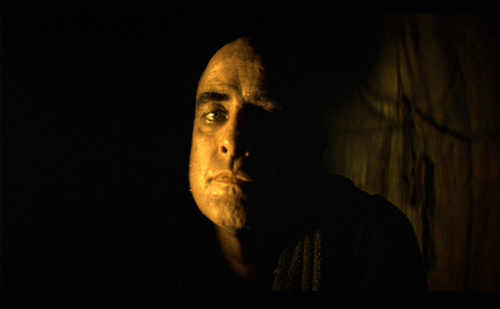Another gem. Originally published in the June 1989 issue of Esquire. Republished here with the permission of the late author’s son, Mark Kram Jr., a wonderful storyteller in his own right. His postscript follows. For a contemporary, but very different, glimpse of Ali, check out Davis Miller’s story about his day with the champ.
Great Men Die Twice
By Mark Kram
There is the feel of a cold offshore mist to the hospital room, a life-is-a-bitch feel, made sharp by the hostile ganglia of medical technology, plasma bags dripping, vile tubing snaking in and out of the body, blinking monitors leveling illusion, muffling existence down to a sort of digital bingo. The Champ, Muhammad Ali, lies there now, propped up slightly, a skim of sweat on his lips and forehead, eyes closed, an almost imperceptible tremor to his arms and head. For all his claims to the contrary, his surface romance with immortality, Ali had a spooky bead on his future; he never saw it sweeping grandly toward him but bellying quietly along the jungle floor. “We just flies in a room,” he liked to say, moving quickly across the ruins of daily life, plane crashes, train wrecks, matricide, infanticide; then after swatting half of humanity, he’d lower his voice and whisper, as if imparting a secret, “We just flies, that’s all. Got nowhere to fly, do we?”
Images and echoes fill the room, diffuse and speeding, shot through with ineluctable light and the mythopoeic for so long, the glass darkened to a degree no one thought possible; his immense talent, his ring wisdom, his antipathy for chemicals, argued against destructibility; all he would ever do is grow old. For twenty years, while he turned the porno shop of sports into international theater, attention was paid in a way it never was before or has been since. The crowds were a wonder to behold. Kids scaled the wings of jets to get a glimpse of him; thousands, young and old, tailed him in masses during his roadwork. World leaders marveled at the spell he cast over the crowds. “If you were a Filipino,” joked Ferdinand Marcos, “I’d have to shoot you.” The pope asked for his autograph; Sure, he said, pointing to a picture, but why ain’t Jesus black? A young Libyan student in London sat on his bed, kept him up half the night with dithyrambic visions of Muslim revolution. “Watch, one day you will see,” said Muammar Qaddafi. Half asleep, Ali said: “Sheeeet, you crazy.” Leonid Brezhnev once dispatched a note to an official at Izvestia: “I would like to see more on Muhammad Ali. Who is this man?”
The Ali Watch: how absurd that it would one day drop down here on a little hospital on Hilton Head Island, South Carolina. The nurse dabs his face dry. What is he thinking? Never has his favorite phrase sounded so dismally precise: My, my, ain’t the world strange. If he could root back through the maze of moment and incident, would he find premonitory signs sticking out like dire figurations of chicken entrails? Does he remember King Levinsky, one of the many heavy bags for Joe Louis, in the corridor after the Miami Beach weigh-in? Boldly colored ties draped Levinsky’s neck (he sold them on the street), his synapses now like two eggs over-light, in permanent sizzle, as he tried to move into stride with a young Cassius Clay. Over and over, like a one-man Greek chorus, Levinsky croaked, eyes spinning, spittle bubbling from his lips: “He’s gonna take you, kid. Liston’s gonna take you, make you a guy sellin’ ties… Partners with me kid, ya kin be partners with me.” Does he remember a shadowed evening in his hotel room a day or so after the third Joe Frazier fight, moving to the window, his body still on fire from the assault? He stood there watching the bloodred sun drop into Manila Bay, then took a visitor’s hand and guided it over his forehead, each bump sending a vague dread through the fingers. “Why I do this?” he said softly. Does he remember the Bahamian cowbell tinkling the end of his final, pathetic fight, a derisive goodbye sound stark with omen? What is he thinking?
Ali poses a question, his eyes closed, his lips parting as if he were sliding open manhole covers. “You die here…. they take you home?” he asks. The nurses roll their eyes and smile, struck by his innocence; it has nothing to do, they know, with morbidity. He is not joking either. The practical aftermath of death seems to stimulate his curiosity these days; nothing urgent, mind you, just something that begins to get into your mind when you’re watching blood move in and out of your body for half the day. Though he is very much a mystic, there is a part of Ali that has always found security and a skewed understanding of life in the quantifiable: amounts, calibrated outcomes, the creaking, reassuring machinery of living. The night before in the hotel lounge, with his wife, Lonnie, beside him, bemusedly aghast, he grilled a pleasant waitress until he knew how many tips she got each week, how many children she had, the frequency of men hitting on her, and the general contour of her reality. “She have a sad life,” he said later. The nurse now cracks with a deadpan expression: “You die, we take you home, Muhammad.
Still, a certain chiaroscuro grimness attaches to their surreal exchange and cries out for some brainless, comic intervention. He himself had long been a specialist in such relief when he would instantly brighten faces during his favorite tours of prisons, orphanages, and nursing homes. When down himself (very seldom), he could count on a pratfall from his hysterical shaman, Drew “Bundini” Brown, on the latest bizarre news from his scheming court, maybe a straight line from some reporter that he would turn into a ricocheting soliloquy on, say, the disgusting aesthetics of dining on pig. No laughs today, though.
“Don’t make him laugh,” a nurse insisted when leading a writer and a photographer into the room. “Laughing shakes the tubing loose.” The photographer is Howard Bingham, Ali’s closest friend; he’s been with the Champ from the start, in the face of much abuse from the Black Muslims. Ali calls him “the enemy” or “the nonbeliever.” His natural instinct is to make Ali laugh; today he has to settle for biting his lower lip and gazing warily back and forth between Ali and his nurses. He doesn’t know what to do with his hands. Ali had requested that he leave his cameras outside; just one shot of this scene, of Ali on his back, the forbidding purge in progress, of fame and mystique splayed raw, would bring Bingham a minor fortune. “He doesn’t want the world to see him like this,” says Howard. “I wouldn’t take the picture for a million dollars.”
The process is called plasmapheresis. It lasts five hours and is being conducted by Dr. Rajko Medenica. The procedure, popular in Europe, is a cleansing of the blood. Ali is hooked up to an electrocardiograph and a blood-pressure monitor; there is always some risk when blood is not making its customary passage. But the procedure is not dangerous and he is in no pain, we are told. Two things, though, that he surely can’t abide about the treatment: the injection of those big needles and the ceaseless tedium. When he was a young fighter, a doctor had to chase him around a desk to give him a shot, and chaotic mobility to him is at least as important as breathing. Bingham can’t take his eyes off Ali; the still life of his friend, tethered so completely, seems as incomprehensible to him as it would to others who followed the radiated glow of Ali’s invulnerability. The nurses cast an eye at his blood pressure and look at each other. His pressure once jumped twelve points while he watched a TV report on Mike Tyson’s street fight with Mitch Green in Harlem. It’s rising a bit now, and the nurses think he has to urinate. He can’t bear relieving himself in the presence of women; he resists, and his anxiety climbs.
“Ali,” one of them calls. His eyes remain closed, his breathing is hardly audible. The nurse calls to him again; no response. “Come on now, Ali,” she complains, knowing that he likes to feign death. “Now, stop it, Ali.” He doesn’t move, then suddenly his head gives a small jerk forward and his eyes buck wide open, the way they used to when he’d make some incoherent claim to lineage to the gods. The nurses flinch, or are they in on the joke, too? Eyes still wide, with a growing smile, he says to the writer, weakly: “You thought I dead, tell the truth. You the only one ever here to see this and I die for ya. You git some scoop, big news round the whole world, won’t it be?” He leans his head back on the pillow, saying: “Got no funny people round me anymore. Have to make myself laugh.” The nurse wants to know if he has to urinate. “No,” he says with a trace of irritation. “Yes, you do,” the nurse says. “Your pressure…” Ali looks over at Lonnie with mischievous eyes. “I just thinkin’ ’bout a pretty woman.” The nurse asks him what he’d like for lunch. “Give him some pork,” cracks Bingham. Ali censures the heretic with a playful stare. Ali requests chicken and some cherry pie with “two scoops of ice cream.” He turns to the writer again: “Abraham Lincoln went on a three-day drunk, and you know what he say when he wake up?” He waits for a beat, then says: “I freed whooooooo?” His body starts to shake with laughter. The nurse yells: “Stop it, Muhammad! You’ll drive the needles through your veins.” His calms down, rasps, “I’ll never grow up, will I? I’ll be fifty in three years. Old age just make you ugly, that’s all.”
Not all, exactly; getting old is the last display for the bread-and-circuses culture. Legends must suffer for all the gifts and luck and privilege given to them. Great men, it’s been noted, die twice—once as great, and once as men. With grace, preferably, which adds an uplifting, stirring, Homeric touch. If the fall is too messy, the national psyche will rush toward it, then recoil; there is no suspense, no example in the mundane. The captivating, aspiring sociopath Sonny Liston had a primitive hold on the equation of greatness. “Clay (he never called him Ali) beeeg now,” Sonny once said while gnawing on some ribs. “He flyin’ high now. Like an eagle. So high. Where he gonna land, how he gonna land? He gonna have any wings? I wanna see.” Sonny, of course, never made it for the final show. Soon after, he checked out in Vegas, the suspicion of murder hovering over the coroner’s report.
Who wanted to ask the question back then, or even be allowed to examine in depth its many possibilities? It was too serious for the carnival, immediately at odds with the cartoon bombast that swirled around Ali, the unassailable appeal of the phenomenon, the breathtaking climb of the arc. Before him, the ring, if not moribund, had been a dark, somber corner of sports, best described by the passing sight of then-middleweight-king Dick Tiger, leaving his beat-up hotel wearing a roomy black homburg and a long pawnshop overcoat, a black satchel in his hand, heading for the subway and a title fight at the Garden. But the heavyweight champions—as they always will—illuminated the image sent out to the public. There was the stoic, mute Joe Louis, with his cruising menace; street fighter Rocky Marciano, with his trade-unionist obedience; the arresting and dogged Floyd Patterson, who would bare his soul to a telephone pole at the sight of a pencil; all unfrivolous men who left no doubt as to the nature of their work.
With the emergence of Muhammad Ali, no one would ever see the ring the same way again, not even the fighters themselves; a TV go, a purse, and sheared lip would never be enough; and a title was just a belt unless you did something with it. A fighter had to be; a product, an event, transcendental. Ali and the new age met stern, early resistance. He was the demon loose at a holy rite. With his preening narcissism, braggart mouth, and stylistic quirks, he was viewed as a vandal of ring tenets and etiquette. Besides, they said, he couldn’t punch, did not like to get hit, and seemed to lack a sufficient amount of killer adrenaline. True, on the latter two counts. “I git no pleasure from hurtin’ another human bein’,” he used to say. “I do what I gotta do, nothin’ more, nothin’ less.” As far as eating punches, he said, “Only a fool wanna be hit. Boxin’ just today, my face is forever.” Others saw much more. The ballet master Balanchine, for one, showed up at a workout and gazed in wonder. “My God,” he said, “he fights with his legs, he actually fights with his legs. What an astonishing creature.” Ali’s jab (more like a straight left of jolting electricity) came in triplets, each a thousandth of a second in execution. He’d double up cruelly with a left hook (rarely seen) and razor in a right—and then he’d be gone. Even so, it took many years for Ali to ascend to a preeminent light in the national consciousness. In the Sixties, as a converted Black Muslim, he vilified white people as blond, blue-eyed devils. His position on Vietnam—”I ain’t got no quarrel with those Vietcong, anyway. They never called me nigger”—was innocent at first, but then taken up as if he were the provocateur of a national crisis. The politicians, promoters, and sweeping sentiment converged to conspire against his constitutional right to work; states barred him from fighting. He resisted the draft and drifted into exile. Three years later he returned, heavier, slower, but with a new kind of fire in his belly. Though he had defeated heavyweight champion Sonny Liston and defended his title nine times, Ali had never had a dramatic constituency before. Now a huge one awaited him, liberals looking for expression, eager literati to put it into scripture, worn-out hippies, anyone who wanted to see right done for once. The rest is history: the two symphonic conflicts with Joe Frazier; the tingling walk with him into the darkness of George Foreman. Then, the Hegelian “bad infinite” of repeating diminishing cycles: retiring, unretiring, the torture of losing weight, the oiling of mushy reflexes. The margins of dominance compressed perilously, and the head shots (negligible before exile) mounted.
Greatness trickled from the corpus of his image, his career now like a gutshot that was going to take its time before killing. His signing to fight Larry Holmes, after retiring a second time, provoked worried comment. After watching some of Ali’s films, a London neurologist said that he was convinced Ali had brain damage. Diagnosis by long distance, the promoters scoffed. Yet among those in his camp, the few who cared, there was an edginess. They approached Holmes, saying, “Don’t hurt him, Larry.” Moved, Holmes replied: “No way. I love Ali.” With compassion, he then took Ali apart with the studied carefulness of a diamond cutter; still, not enough to mask the winces at ringside. Ali failed to go the route for the first time in his career. Incredibly, fourteen months later, in 1981, his ego goaded him to the Bahamas and another fight, the fat jellied on his middle, his hand-speed sighing and wheezing like a busted old fan; tropic rot on the trade winds. Trevor Berbick, an earnest pug, outpointed him easily. Afterward, Angelo Dundee, who had trained Ali from the start and had to be talked into showing up for this one, watched him slumped in the dressing room, then turned away and rubbed his eyes as certain people tried to convince Ali that he had been robbed and that a fourth title was still possible.
The public prefers, indeed seems to insist on, the precedent set by Rocky Marciano, who quit undefeated, kept self-delusion at bay. Ali knew the importance of a clean farewell, not only as a health measure but as good commercial sense. His ring classicism had always argued so persuasively against excessive physical harm, his pride was beyond anything but a regal exit. But his prolonged decline had been nasty, unseemly. Who or what pressured him to continue on? Some blamed his manager, Herbert Muhammad, who had made millions with Ali. Herbert said that his influence wasn’t that strong.
Two years after that last fight, Ali seemed as mystified as everyone else as to why he hadn’t ended his career earlier. His was living with his third wife, the ice goddess Veronica, in an L.A. mansion, surrounded by the gifts of a lifetime—a six-foot hand carved tiger given to him by Teng Hsiao-ping, a robe given to him by Elvis Presley. Fatigued, his hands tremoring badly, he sat in front of the fire and could only say: “Everybody git lost in life. I just git lost, that’s all.”
Now, five years later, the question why still lingers, along with the warning of the old aphorism that “we live beyond what we enact.” The resuscitation of Ali’s image has been a sporadic exercise for a long time now, some of it coming from friends who have experienced heartfelt pain over his illness. Others seem to be trying to assuage a guilt known only to themselves, and a few are out to keep Ali a player, a lure to those who might want to use his name in business; though the marketplace turns away from billboards in decline. Not long ago, a piece in The New York Times Magazine pronounced him the Ali of old, just about terminally perky. Then, Ali surfaced in a front-page telephone interview in The Washington Post. He appeared to have a hard grasp on politics, current states’ rights issues, and federal judgeships being contested—a scenario that had seemed as likely as the fusillade of laser fire Ali said Muslim spaceships would one day loose on the white devils.

Noses began to twitch. What and who was behind the new Ali, the wily Washington lobbyist who had the ear of everyone from Strom Thurmond to Orrin Hatch? The wife of Senator Arlen Specter even baked Ali a double-chocolate-mousse pie. For a good while, most of these senators, and others, knew only the voice of Ali on the phone. Dave Kindred, a columnist for The Atlanta Journal-Constitution who has known Ali since his Louisville days, concluded that it was most likely Ali’s attorney, Richard Hirschfeld, widely regarded as a brilliant impersonator of Ali, who had made the calls. (Hirschfeld has refused to comment on whether or not he did so.) Hirschfeld and Ali had cut up a lot of money over the years on numerous enterprises (funded by other people), from hotels to cars, most of them failing. Ali’s lobbying seemed to center on a federal judgeship for a Hirschfeld friend, and a federal lawsuit in which Ali sought $50 million in damages from his “wrongful conviction in the 1967 draft evasion case.” He lost the suit but succeeded in getting Senator Hatch and others to explore a loophole that might remedy the verdict. Ali eventually had to materialize (with Hirschfeld hard by his side), and many on Capitol Hill were unable to match the man with the voice. One of Sam Nunn’s aides, noting Ali’s listlessness and Hirschfeld’s aggressive quizzing, wondered: “Is Ali being carted around like a puppet?” Certainly a serpentine tale; but had Ali been a collaborator all along?
At his farm in Berrien Springs, Michigan, Ali sits at the end of a table in the living room. The 247 pounds of weight have made him a bit short of breath. He’s battled his appetite (two, three desserts, meals back to back) and sedentary lapses for years. Several months before, he had been almost sleek, thanks to fourteen-mile walks and his wife’s efforts to police him at the table. But what is disturbing is the general profile of his condition.
For a long time now, he had appeared indifferent to the ravages of his problem. But he dispels that notion when asked how seriously he considered a dangerous brain operation in Mexico before his family talked him out of it. “Scale of ten,” he says, “a six.” The answer reflects the terrible frustration that must exist within him, the daily, fierce struggle with a body and mind that will not capitulate to his bidding. He sits there, his hands shaking, his movements robotic, the look on his face similar to what the Marines call a thousand-yard stare.
Why is it, do you think, that after all these years, the dominant sound around Ali is silence? Look at the cataract of noise caught by TV sound men, look at the verbosity that snared some novelists into thinking he was a primitive intelligence capable of Ciceronian insight. Part of the fever of the times; if the Black Panther Huey Newton, posing with a rifle and spear, could be written up as a theoretical genius, and his partner, Bobby Seale, interpreted as a tactical wizard, then how much a symbol was Ali, the first to tap and manifest glinting black pride, to dispute with vigor erosive self-laceration.
The fact was that he was not cerebral; he was a reflex of confusing emotions and instant passions. He did have street cunning, most of it aimed at keeping himself a mystery. “People like mystery,” he used to say. “Who is he? What’s he all about? Who’s he gonna be tomorrow?” To that end, he tossed the media rabble dripping hunks of redundant, rote monologue; his loudness provided a great show and diverted probing questions. By nature, he was gentle, sensitive man, and even in the throes of angry threats against whites it was hard to hide a smile, for he loved what the blacks call “selling wolf tickets,” tricking people into fear. The Black Panthers used that gambit well, and the TV crews followed their presence. Thinking of all of this, how could someone so alien to ideas, and thought, who communicated privately, in scraps and remote silences, be capable of fooling Washington politicians? Absurd, of course, but then the question emerges: Did he allow himself to be used?
“How about all those phone calls,” he is asked.
“What calls?” he responds, vacantly.
“To politicians, this past summer.”
“You can’t believe that,” he says. “Man wrote that, he’s cracker from way back in Louisville. Always hated blacks.”
“But the piece had the goods.”
“I’m signin’ my autographs now,” he says. “This is the only important thing in my life. Keepin’ in touch with the people.”
“Were you used?”
“Spend a hundred dollars on stamps every week. Give ’em all my autograph that write me.”
“Were you used?”
“For what?”
“To influence your lawsuit.”
“I ain’t worried about money,” he says.
“Maybe you just want to be big again. Remember what you told Elvis. ‘Elvis, you have to keep singin’ or die to stay big. I’m gonna be big forever.'”
He smiles thinly: “I say anything shock the world.”
“You like politics now?”
“Politics put me to sleep.”
“You were at the Republican National Convention.”
“You borin’ me, putting me to sleep.”
“Reagan, Hatch, Quayle, they would’ve clapped you in jail in the old days.”
His eyes widen slightly: “That right?” He adds: “I’m tired. You better than a sleepin’ pill.”
But don’t let the exchange mislead. Ali is not up to repartee these days, never was, really, unless he was in the mood, and then he’d fade you with one of his standard lines (“You not as dumb as you look”). He speaks very, very slowly, and you have to lean in to hear him. It takes nearly as hour to negotiate the course of a conversation. Typically, he hadn’t been enlightening on the Capitol Hill scam. Over the years, he has been easily led, told by any number of rogues what his best interests were. If the advisors were friends who appealed to his instinct to help them move up a rung, he was even more of a setup. Later, Bingham says: “Ali was pissed about that impersonation stuff. He had no idea.” Why didn’t he just say that he didn’t make the calls? “You know him,” he says. “He’ll never betray who he thinks has tried to help him. The idea that people will think less of him now bothers him a lot.”
If there was ever any doubt about the staying power of Ali, it is swept aside when you travel with him. His favorite place in the world—next to his worktable at his farm—is an airport. So he should be in high spirits now; he’ll be in three airports before the day’s over. But he’s a bit petulant with Lonnie, who aims to see that he keeps his date at Hilton Head Island. He can’t stand hospitals. They get in the way of life. He found it hard to ever visit his old sidekick Bundini when he was dying. Paralyzed from the next down, Bundini could only move his eyes. Ali bent down close to his ear and whispered: “You in pain?” The eyes signaled “yes.” Ali turned his head away, then came back to those eyes, saying: “We had some good times, didn’t we?” Bundini’s eyes went up and down. Ali talks about this in the Chicago airport. He’s calmed down now, sits off by himself, ramrod-straight and waiting. He wears a pinstripe suit, red tie, and next to him is his black magician’s bag; he never lets it out of his sight. The bag is filled with religious tracts already autographed; which is the first thing he does every day at 6:00 a.m., when he gets up. All he has to do is fill in the person’s name.
His autograph ritual and travel are his consuming interests. He’ll go anywhere at the ring of a phone, and he spends much time on the road. Perhaps the travel buoys him; he certainly gets an energy charge from people. Soon they begin to drop like birds to his side. “You see,” he says, “all I gotta do is sit here. Somethin’, ain’t it? Why they like me?” He is not trying to be humble, he is genuinely perplexed by the chemistry that exists between himself and other people. “Maybe they just like celebrities,” he says. Maybe, he’s told, he’s much more than a celebrity. He ponders that for a moment, and says: “That right?” By now, a hundred people have lined up in front of him, and a security guard begins to keep them in line. Ali asks them his name, writes, then gives them his autographed tracts. Some ask him to pose for pictures, others kid him about unretiring. “Kong (Mike Tyson), I’m comin’ after you.” Near the end, he does a magic trick for a lady, using a fake thumb. “Where you going, Muhammad?” she asks. He thinks, and then leans over to the writer and asks: “Where we going?” The lady’s eyes fill, she hugs him and says: “We love you so much.” What is it that so movingly draws so many people—his innocent, childlike way, the stony visual he projects, set off against his highly visible symptoms?
That night over dinner, Ali’s eyes open and close between courses. He fades in and out of the conversation, has a hint of trouble lifting the fork to his mouth. His days includes periods like this, he’s in and out like a faraway signal. Sometimes he’s full of play. He likes to swing his long arm near a person’s ear, then create a friction with thumb and forefinger to produce a cricket effect in the ear. Then the play is gone, and so is he. “One day,” Lonnie is saying, “I want someone to catch his soul, to show what a fine human being he is.” Ali says, head down: “Nobody know me. I fool ’em all.” Lonnie is Ali’s fourth wife. She was a little girl who lived across from Ali’s old Louisville home when he was at the top. She is a woman of wit and intelligence, with a master’s degree in business administration. She plans his trips, is the tough cop with him and his medicine, and generally seems to brighten his life. Ice cream dribbles down Ali’s chin. “Now, Muhammad,” she says, wiping it away. “You’re a big baby.” He orders another dessert, then says: “Where are we?” A blade of silence cuts across the table.
Bingham says: “Hilton Head Island.”
Ali says: “Ya ever wake up and don’t know where you are?” Sure, he is told, steady travel can make a person feel like that for an instant; yet it is obvious that short term-memory for him is like a labyrinth.
Ali’s day at the hospital is nearly over. He will soon be counting down the minutes. Right now, he’s in high spirits. A nurse has secretly slipped him some strips of paper. He has a complete piece of paper in his hands. He crumples the paper, pretends to put it in his mouth, then billows his cheeks until he regurgitates tiny pieces all over his chest. “Ain’t magic a happy thing,” he says, trying to contain his giggling. When Dr. Medenica comes, Ali jokes with him. The doctor goes about examining the day’s results. He looks at the bags of plasma: 15,000 cc’s have been moved through Ali. Floyd Patterson has expressed dismay over the current treatment. “No brain damage?” Floyd has said. “Next you’ll be hearing he was bit by a cockroach. He’s gonna kill Clay…. He’ll drop dead in a year.” Medenica bridles at the comment. “He’s rather ignorant. I’m going to have to call that man.” Ali wants to know what Patterson said. Nobody wants to tell him. “Tell me,” says Ali. Everyone looks at each other, and someone finally says: “Floyd says you’ll drop dead in a year.” Ali shrugs it off: “Floyd mean well.”
It is Medenica’s contention that Ali suffers from pesticide poisoning. Though his work has met with some skepticism in the medical community, Medenica is respected in South Carolina. His desk is rimmed with pictures of prominent people—a senator, a Saudi prince, an ambassador—patients for whom he has retarded death by cancer. He is supposed to have done wonders for Marshal Tito of Yugoslavia. Tito was so grateful, he arranged funding for Medenica’s clinic in Switzerland. When he died, the funds were cut off and Medenica was left with bills and criminal indictment by the Yugoslavians and the Swiss. “Don’t ask how Ali got the pesticides,” Medenica says.
Plasmapheresis is a solid treatment for pesticide poisoning, which occurs more than ever these days. The blood cleaning removes the immune complex, which in turns removes toxins. But how can Medenica be so sure that Ali’s problem is not brain damage? Dr. Dennis Cope, of UCLA, has said that Ali is a victim of “Parkinson’s syndrome secondary to pugilistic brain syndrome.” In short, he took too many head shots. Medenica, though, is a confident man.
He predicts Ali will be completely recovered. “I find absolutely no brain damage. The magnetic resonator tests show no damage. Before I took him as a patient, I watched many of his fight films. He did not take many head blows.”
Is he kidding?
“No, I do not see any head blows. When he came this summer, he was in bad shape. Poor gait. Difficult speech. Vocal cord syndrome, extended and inflamed. He is much better. His problem is he misses taking his medicine, and he travels too much. He should be here once a month.”
Finally, Ali is helped out of his medical harness. He dresses slowly. Then, ready to go out, he puts that famous upper-teeth clamp on his bottom lip to show determination and circles the doctor with a cocked right fist. His next stop is for an interferon shot. It is used to stimulate the white blood cells. Afterward, he is weak, and there is a certain sadness in his eyes. On the way to the car, he is asked if the treatment helps. He says: “Sheeeet, nothin’ help.”
The Lincoln Town Car moves through the night. Bingham, who is driving, fumbles with the tape player. Earlier in the day, he had searched anxiously for a tape of Whitney Houston doing “The Greatest Love of All,” a song written especially for Ali years ago. He had sensed that Ali would be quite low when the day was over, and he wanted something to pick him up. The words, beautiful and haunting, fill the car.
Everybody’s searching for a hero,
People need someone
To look up to,
I never found anyone who
Fulfilled that need;
A lonely place to be,
So learned to depend on me.
I decided long ago
Never to walk in anyone’s shadow;
If I fail, if I succeed
At least I lived as I believe,
And no matter what
They take from me,
They can’t take away my dignity;
Because the greatest love of all
Is happening to me
I found the greatest love of all
Inside of me.
The greatest love of all is easy
To achieve,
Learning to love yourself
It is the greatest love of all.
“You hear that,” Bingham says, his voice cracking. “Everything’s gonna be just fine, Ali.”
The dark trees spin by. There is no answer. What is he thinking?
Postscript
This 1989 Esquire piece by father on Ali in decline is one of my personal favorites. I am not exactly sure what he thought of it; he was the last person to go to for an opinion on any of his work. But I like it immensely. It blends his characteristic impressionistic style with exquisite reporting, grim humor and an undercurrent of compassion born of their long years together. Although my father took some swipes at Ali in his 2001 book, Ghosts of Manila: The Fateful Blood Feud Between Muhammad Ali and Joe Frazier, I think he comes at his subject in this piece with his lance sheathed. He had always told me he had been of fond Ali personally and I think that comes across here. It is a tender glimpse at a once extraordinary athlete who has been thrust by age and illness into a state of sad fragility.
–Mark Kram Jr., author of Like Any Normal Day: A Story of Devotion, the winner of the 2013 PEN/ESPN Award for Literary Sports Writing. See more at www.markkramjr.com.
Mark Kram covered much of Ali’s career for Sports Illustrated, including all three of his bouts with Joe Frazier. He began his 40 year writing career as sports columnist as The Baltimore Sun in 1959. He spent 13 years at SI (1964-1977), during which he became one of the signature voices of the magazine. He later contributed pieces to Playboy, Esquire, and GQ. Ghosts of Manila, his book on the Ali-Frazier rivalry, was published by HarperCollins in 2001. He died in 2002.











































